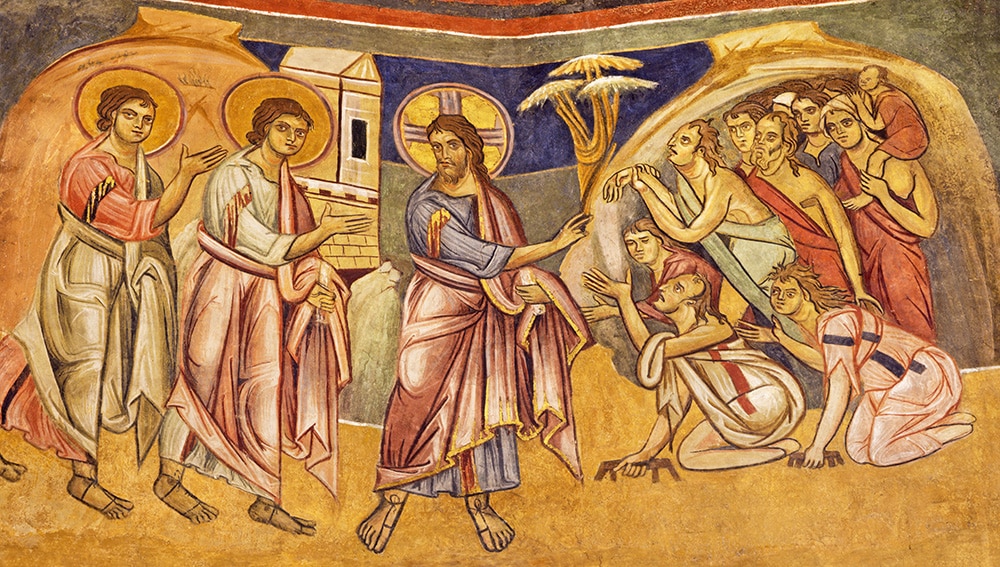Dear Friend,
One of the most joy-filled things I’ve ever read is a letter that begins “I have a brain tumor.” The author was in her early 30s: wife to a devoted husband, mother to four young children, friend to really good friends. Her diagnosis was terminal and she knew it. Beth Haile was dying, and she was joyful.
This is not to say that she was happy about dying. She loved her life, her husband, her children and her friends. She did not want to leave this world or for those she loved to be without her. She was joyful even though she wasn’t happy about everything.
Four years before the letter about her terminal diagnosis, Beth wrote another letter about re-prioritizing her life. After a year of prayer and discernment, she decided to rebalance her work-life balance. She couldn’t do everything, so she made intentional choices about what to place first in her life, next, and so on. By the time her brain tumor was discovered, she was several years in to living with her clarified commitments. She found joy, even though she sacrificed many things to live out these commitments.
Read more from the Letters to a Young Catholic series here.
One year after she wrote the letter about her diagnosis, Beth Haile died. She died with sorrow for the separation from her husband and children and friends and this world, and she died with gratitude for it all. Happiness is a fickle thing, but joy is wide enough to hold sorrow and gratitude.
I’ve read Beth’s public letters many times. I see her as a witness to joy. She found joy in this life and awaited the joy of the life to come. Those are not separate joys but the same joy. The joy begun in her here will be complete in the hereafter.
I don’t tell you about Beth as some “you might die tomorrow” ploy. Even had she lived, I would still consider her a witness to joy. The joy was there as much in the earlier letter as it was in the later one. There were things she liked in the way her life was before she reprioritized, and she had to leave some of those things behind. It hurt to do that. But she was willing to heed a deeper calling by moving beyond what had become comfortable and customary, opening herself to a fullness of life, in joy.
Her early death is not what made her life full, though the way she approached her early death shows us the fruits of living life fully now. She was free to embrace sorrow for the things that were sorrowful and exude gratitude for what made her grateful. She revealed what joy is.
Beth’s witness says something we need to hear: you have to be willing to leave happiness to find joy.
The sacrifice of joy
If we were to consider perhaps the greatest saint of the 20th century, we would find something very similar in her to what we find in Beth. From studying Mother Teresa of Calcutta, praying with her and writing about her, I discovered that she, too, left happiness to find joy.
Mother Teresa rarely spoke about her childhood, but the few times she did she always said she came from a happy home. Her father taught her to welcome people, especially the poor, into their home to share what they had. Her mother taught her how to leave their happy home to tend to the needs of people in their community. She learned early that her happy home was a place into which to welcome people and out of which to serve people. When as a teenager she was called to join a religious community serving children in faraway India, the cost of following that call was leaving her happy childhood home behind forever. She went.
The pain of leaving home brought Sister Teresa to educate the Bengali poor in India. She was very happy. In fact, even later in life, she said that living as a Sister of Loreto was the happiest she had ever been. But eventually, she came to learn of people even poorer than the ones she was already serving, and soon after that she discerned a very clear call from the Lord to go serve these “poorest of the poor.” She was happy in Loreto, but she did not cling to her own happiness. Instead, she began seeking permission from her religious superiors to follow this specific calling. When, after two years, permission was granted, she left Loreto behind forever.
The pain of leaving Loreto brought Mother Teresa — and the Missionaries of Charity who followed after her — into the joy of loving the poorest of the poor, first on the streets of Calcutta and then across the world. Seeing those dying on the streets with no one to care for them, Teresa brought them into homes to be loved and respected. Seeking out those whose misery was hidden in forgotten places, Teresa went to keep them company, to bring them the light of love.
Following the joyful

Mother Teresa became a witness to joy. One man changed by this witness was a very accomplished media professional named Malcolm Muggeridge, who went to India to profile Mother Teresa. Slowly, he began to marvel at her and her fellow missionaries, but something else happened to him, too. Here’s how he put it:
“Accompanying Mother Teresa … to the Home for the Dying, to the lepers and unwanted children, I found I went through three phases. The first was horror mixed with pity, the second compassion pure and simple, and the third, reaching far beyond compassion, something I have never experienced before — an awareness that these dying and derelict men and women, these lepers with stumps instead of hands, these unwanted children, were not pitiable, repulsive or forlorn, but rather dear and delightful” (“Something Beautiful for God,” HarperOne, $16.99).
Malcolm was afraid of deformity, sickness and poverty. He was content in his clean, orderly life. Following Mother Teresa brought him to what he feared. But there, in the midst of the poor and suffering, he started to change because he didn’t run away. Not only was he moved to compassion, he even began to delight in the very people that previously repulsed him. He felt companionship with them, he delighted in them, he found joy.
Where to set our hearts
We routinely fail to seek after what we are meant for. We cling to our lesser pleasures, our safeties, our conveniences and routines. We neglect the call to joy.
C.S. Lewis wrote about this in a famous sermon:
“It would seem that Our Lord finds our desires not too strong, but too weak. We are half-hearted creatures, fooling about with drink and sex and ambition when infinite joy is offered us. … We are far too easily pleased” (“The Weight of Glory”).
God does not mean for us to turn off our desires; in fact, our desires are meant to be inflamed. Settling for too little prevents us from desiring more — for ourselves and for each other. We are made for that confounding joy Beth Haile tasted. The joy that Mother Teresa sought is no greater than the joy meant for us. We may not think we want that joy, but our dissatisfaction with everything short of it is a sign that we are made to be not half-hearted but full-hearted creatures.
What was true for Beth, Teresa and Malcolm is true for us: We have to be willing to leave happiness to find joy. It is one and the same joy: the joy of Christ.
If you cannot believe in Christ, then practice doing what people like Beth and Teresa did. Be willing to leave happiness and comfort. Go toward those in need. Make the sufferings of others your own. Rejoice in other people’s good. If you do that, you’ll already be moving in the ways of God. Sometimes we get to belief by way of action, even if it takes a long time to get there.
The truth is: there is no joy without God. Truly, I am not as joyful as I should be. Pray that I may grow in joy, giving my life over more and more to God, to the ways of God. And I will pray the same for you.
Sincerely,
Leonard J. DeLorenzo, Ph.D., works in the McGrath Institute for Church Life and teaches theology at the University of Notre Dame. Subscribe to his weekly newsletter, “Life, Sweetness, Hope,” at bit.ly/lifesweetnesshope.






